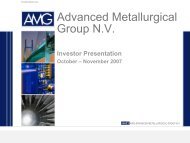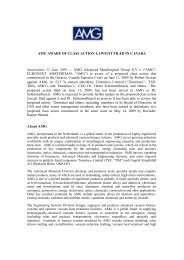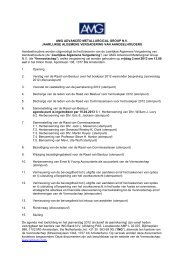C Si Ni Cr V Ti Ta Sc Li Sr Zr Fe Cu Zn Sn B Al Ce U Mn Mo Nb Sb
C Si Ni Cr V Ti Ta Sc Li Sr Zr Fe Cu Zn Sn B Al Ce U Mn Mo Nb Sb
C Si Ni Cr V Ti Ta Sc Li Sr Zr Fe Cu Zn Sn B Al Ce U Mn Mo Nb Sb
Create successful ePaper yourself
Turn your PDF publications into a flip-book with our unique Google optimized e-Paper software.
the subsidiaries have a 100% interest in these funds.<br />
Rehabilitation and restoration trust funds holding monies<br />
committed for use in satisfying environmental obligations<br />
are included on a discounted basis within other noncurrent<br />
assets on the statement of financial position, only<br />
to the extent that a liability exists for these obligations.<br />
Environmental expense recoveries are generally<br />
recognized in profit upon final settlement with the<br />
Company’s insurance carriers.<br />
Additional environmental remediation costs and<br />
provisions may be required, if the Company were to decide<br />
to close certain of its sites. <strong>Ce</strong>rtain of the Company’s<br />
restructuring programs have involved closure of several<br />
sites to date. Remediation liabilities are recognized when<br />
the site closure has been announced. In the opinion of<br />
the Company, it is not possible to estimate reliably the<br />
costs that would be incurred on the eventual closure of<br />
its continuing sites, where there is no present obligation<br />
to remediate, because it is neither possible to determine<br />
a time limit beyond which the sites will no longer be<br />
operated, nor what remediation costs may be required on<br />
their eventual closure.<br />
(ii) Restructuring<br />
A provision for restructuring is recognized when the<br />
Company or a subsidiary of the Company has approved<br />
a detailed and formal restructuring plan, and the<br />
restructuring either has commenced or has been<br />
announced publicly. Provisions are not made for future<br />
operating costs.<br />
(iii) Warranty<br />
A provision for warranty is recognized when the Company<br />
or a subsidiary of the Company has determined that it<br />
has a basis for recording a warranty provision based on<br />
historical returns for warranty work.<br />
(iv) Partial retirement<br />
In an effort to reduce unemployment and create jobs<br />
for younger job-seekers, Germany implemented certain<br />
regulations in 1996 to enable employees to take early<br />
retirement. <strong>Al</strong>though the law is no longer in effect, the<br />
Company’s German subsidiaries have made provisions for<br />
those employees who are eligible per their employment<br />
contracts. According to German law, the Company is<br />
required to pay a deposit for partial retirements to secure<br />
payments to the employees in the case of insolvency. The<br />
Company records the related deposits and provisions on a<br />
net basis.<br />
(v) Cost estimates<br />
As part of its process to provide reliable estimations of<br />
profitability for long-term contracts, the Company makes<br />
provisions for cost estimates. These provisions are<br />
developed on a contract by contract basis and are based<br />
on contractor estimates.<br />
(n) Revenue<br />
(i) Goods sold<br />
Revenue from the sale of goods is measured at the<br />
fair value of the consideration received or receivable.<br />
Revenue from product sales to the Company’s customers<br />
is recognized when the significant risks and rewards of<br />
ownership have been transferred to the buyer, recovery<br />
of the consideration is probable, the associated costs<br />
and possible return of goods can be estimated reliably,<br />
and there is no continuing management involvement with<br />
the goods.<br />
Transfer of risks and rewards usually occurs when title<br />
and risk of loss pass to the customer. In the case of export<br />
sales, title may not pass until the product reaches a<br />
foreign port.<br />
(ii) Furnace construction contracts<br />
<strong>Ce</strong>rtain furnace construction contracts are reported using<br />
the percentage of completion (“POC”) method. <strong>Cu</strong>mulative<br />
work and services performed to date, including the<br />
Company’s share of profit, is reported on a pro rata basis<br />
according to the percentage completed. The percentage<br />
of completion is measured as the ratio of contract costs<br />
incurred for work performed so far to total contract costs<br />
(cost-to-cost method). Contracts are reported in trade<br />
receivables and advance payments, as “gross amount<br />
due to / from customers for/from contract work (POC)”.<br />
If cumulative work performed to date (contract costs<br />
plus contract net profit) of contracts in progress exceeds<br />
progress payments received, the difference is recognized<br />
as an asset and included in trade and other receivables in<br />
the consolidated statement of financial position. If the net<br />
amount after deduction of progress payments received<br />
is negative, the difference is recognized as a liability<br />
and included in advance payments in the consolidated<br />
statement of financial position. Anticipated losses on<br />
specific contracts are estimated taking account of all<br />
identifiable risks and are accounted for using the POC<br />
method. Contract income is recognized according to<br />
the income stipulated in the contract and/or any change<br />
orders confirmed in writing by the client.<br />
(iii) Commissions<br />
In certain instances, the Company arranges sales for<br />
which the supplier invoices the customer directly. In such<br />
Notes to Consolidated Financial Statements 87







